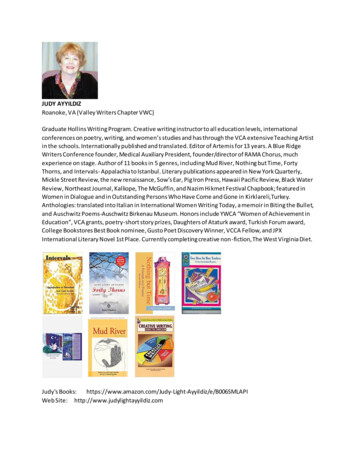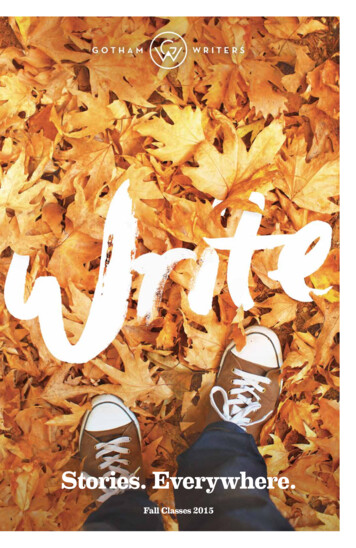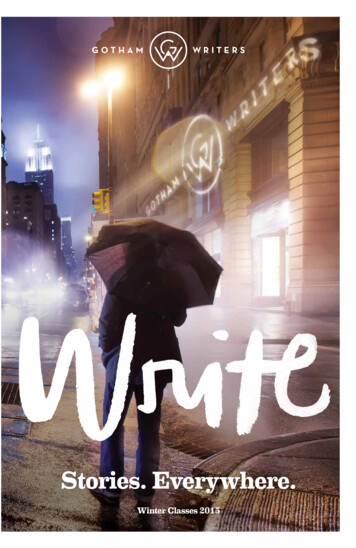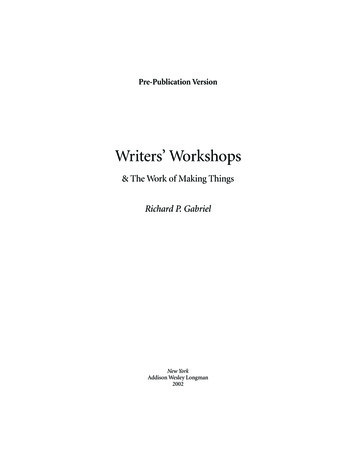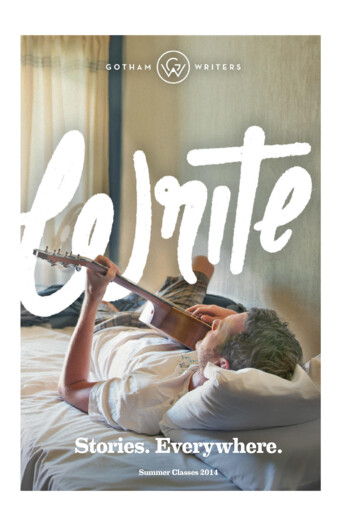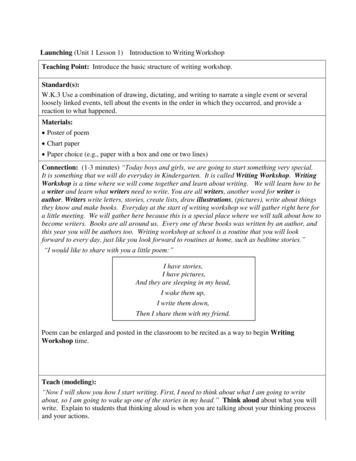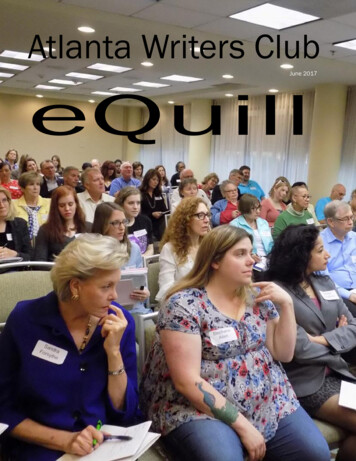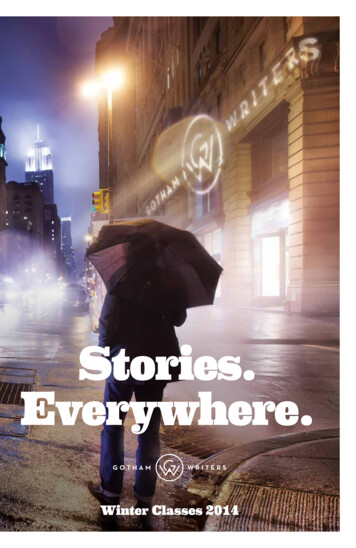
Transcription
A Manual for Writers of Research Papers, Theses, andDissertationsOn Writing, Editing, and PublishingJacques BarzunTricks of the TradeHoward S. BeckerWriting for Social ScientistsHoward S. BeckerPermissions, A Survival Guide: Blunt Talk about Art as Intellectual PropertySusan M. BielsteinThe Craft of TranslationJohn Biguenet andRainer Schulte, editorsThe Craft of ResearchWayne C. Booth,Gregory G. Colomb, andJoseph M. WilliamsGlossary of Typesetting TermsRichard Eckersley,Richard Angstadt,Charles M. Ellerston,Richard Hendel,Naomi B. Pascal, andAnita Walker ScottWriting Ethnographic FieldnotesRobert M. Emerson,Rachel I. Fretz, andwww.itpub.net
Linda L. ShawLegal Writing in Plain EnglishBryan A. GarnerFrom Dissertation to BookWilliam GermanoGetting It PublishedWilliam GermanoA Poet's Guide to PoetryMary KinzieThe Chicago Guide to Collaborative EthnographyLuke Eric LassiterDoing Honest Work in CollegeCharles LipsonHow to Write a BA ThesisCharles LipsonCite RightCharles LipsonThe Chicago Guide to Writing about Multivariate AnalysisJane E. MillerThe Chicago Guide to Writing about NumbersJane E. MillerMapping It OutMark MonmonierThe Chicago Guide to Communicating ScienceScott L. Montgomery
Indexing BooksNancy C. MulvanyGetting into PrintWalter W. PowellTales of the FieldJohn Van MaanenStyleJoseph M. WilliamsA Handbook of Biological IllustrationFrances W. ZweifelChicago Style for Students and ResearchersKate L. TurabianRevised by Wayne C. Booth, Gregory G. Colomb, Joseph M.Williams, and University of Chicago Press Editorial StaffThe University of Chicago PressChicago and Londonwww.itpub.net
Publisher's note: Given the complex formatting of this work, its presentation on an electronic device may differslightly from the print book. Every care has been taken to ensure that readers of this eBook will be able tonavigate the content easily and effectively.Portions of this book have been adapted from The Craft of Research, 2nd edition, by Wayne C. Booth, GregoryG. Colomb, and Joseph M. Williams, 1995, 2003 by The University of Chicago; and from The ChicagoManual of Style, 15th edition, 1982, 1993, 2003 by The University of Chicago.The University of Chicago Press, Chicago 60637The University of Chicago Press, Ltd., London 2007 by The University of ChicagoAll rights reserved. Published 2007Printed in the United States of America16 15 14 13 12 11 10 09 08 071 2 3 4 5ISBN-13: 978-0-226-82338-6 (electronic)ISBN-13: 978-0-226-82336-2 (cloth)ISBN-13: 978-0-226-82337-9 (paper)ISBN-10: 0-226-82336-9 (cloth)ISBN-10: 0-226-82337-7 (paper)Library of Congress Cataloging-in-Publication DataTurabian, Kate L.A manual for writers of research papers, theses, and dissertations : Chicago style for students andresearchers / Kate L. Turabian; revised by Wayne C. Booth, Gregory G. Colomb, Joseph M. Williams, andUniversity of Chicago Press editorial staff.—7th ed.p. cm.“Portions of this book have been adapted from The Craft of Research, 2nd edition, by Wayne C. Booth,Gregory G. Colomb, and Joseph M. Williams, 1995, 2003 by The University of Chicago; and from TheChicago Manual of Style, 15th edition, 1982, 1993, 2003 by The University of Chicago.”Includes bibliographical references and index.ISBN-13: 978-0-226-82336-2 (cloth : alk. paper)ISBN-13: 978-0-226-82337-9 (pbk. : alk. paper)ISBN-13: 978-0-226-82338-6 (electronic)ISBN-10: 0-226-82336-9 (cloth : alk. paper)ISBN-10: 0-226-82337-7 (pbk. : alk. paper)1. Dissertations, Academic—Handbooks, manuals, etc. 2. Academic writing—Handbooks, manuals, etc. I.Title.LB2369.T8 2007808.02—dc222006025443The paper used in this publication meets the minimum requirements of the American National Standard forInformation Sciences—Permanence of Paper for Printed Library Materials, ANSI Z39.48-1992.ContentsA Note to StudentsPrefaceAcknowledgments
Part I Research and Writing: From Planning to ProductionWayne C. Booth, Gregory G. Colomb, and Joseph M. WilliamsOverview of Part I1 What Research Is and How Researchers Think about It1.1 How Researchers Think about Their Aims1.2 Three Kinds of Questions That Researchers Ask2 Moving from a Topic to a Question to a Working Hypothesis2.1 Find a Question in Your Topic2.2 Propose Some Working Answers2.3 Build a Storyboard to Plan and Guide Your Work2.4 Organize a Writing Support Group3 Finding Useful Sources3.1 Understand the Kinds of Sources Readers Expect You to Use3.2 Record Your Sources Fully, Accurately, and Appropriately3.3 Search for Sources Systematically3.4 Evaluate Sources for Relevance and Reliability3.5 Look beyond the Usual Kinds of References4 Engaging Sources4.1 Read Generously to Understand, Then Critically to Engage and Evaluate4.2 Take Notes Systematically4.3 Take Useful Notes4.4 Write as You Read4.5 Review Your Progress4.6 Manage Moments of Normal Panic5 Planning Your Argument5.1 What a Research Argument Is and Is Not5.2 Build Your Argument around Answers to Readers' Questions5.3 Turn Your Working Hypothesis into a Claim5.4 Assemble the Elements of Your Argument5.5 Distinguish Arguments Based on Evidence from Arguments Based on Warrants5.6 Assemble an Argument6 Planning a First Draft6.1 Avoid Unhelpful Plans6.2 Create a Plan That Meets Your Readers' Needs6.3 File Away Leftovers7 Drafting Your Report7.1 Draft in the Way That Feels Most Comfortable7.2 Develop Productive Drafting Habitswww.itpub.net
7.3 Use Your Key Terms to Keep Yourself on Track7.4 Quote, Paraphrase, and Summarize Appropriately7.5 Integrate Quotations into Your Text7.6 Use Footnotes and Endnotes Judiciously7.7 Interpret Complex or Detailed Evidence before You Offer It7.8 Be Open to Surprises7.9 Guard against Inadvertent Plagiarism7.10 Guard against Inappropriate Assistance7.11 Work through Chronic Procrastination and Writer's Block8 Presenting Evidence in Tables and Figures8.1 Choose Verbal or Visual Representations8.2 Choose the Most Effective Graphic8.3 Design Tables and Figures8.4 Communicate Data Ethically9 Revising Your Draft9.1 Check Your Introduction, Conclusion, and Claim9.2 Make Sure the Body of Your Report Is Coherent9.3 Check Your Paragraphs9.4 Let Your Draft Cool, Then Paraphrase It10 Writing Your Final Introduction and Conclusion10.1 Draft Your Final Introduction10.2 Draft Your Final Conclusion10.3 Write Your Title Last11 Revising Sentences11.1 Focus on the First Seven or Eight Words of a Sentence11.2 Diagnose What You Read11.3 Choose the Right Word11.4 Polish It Off11.5 Give It Up and Print It Out12 Learning from Your Returned Paper12.1 Find General Principles in Specific Comments12.2 Talk to Your Instructor13 Presenting Research in Alternative Forums13.1 Plan Your Oral Presentation13.2 Design Your Presentation to Be Listened To13.3 Plan Your Poster Presentation13.4 Plan Your Conference Proposal14 On the Spirit of ResearchPart II Source Citation
15 General Introduction to Citation Practices15.1 Reasons for Citing Your Sources15.2 The Requirements of Citation15.3 Two Citation Styles15.4 Citation of Electronic Sources15.5 Preparation of Citations15.6 A Word on Citation Software16 Notes-Bibliography Style: The Basic Form16.1 Basic Patterns16.2 Bibliographies16.3 Notes16.4 Short Forms for Notes17 Notes-Bibliography Style: Citing Specific Types of Sources17.1 Books17.2 Journal Articles17.3 Magazine Articles17.4 Newspaper Articles17.5 Additional Types of Published Sources17.6 Unpublished Sources17.7 Informally Published Electronic Sources17.8 Sources in the Visual and Performing Arts17.9 Public Documents17.10 One Source Quoted in Another18 Parenthetical Citations–Reference List Style: The Basic Form18.1 Basic Patterns18.2 Reference Lists18.3 Parenthetical Citations19 Parenthetical Citations–Reference List Style: Citing Specific Types of Sources19.1 Books19.2 Journal Articles19.3 Magazine Articles19.4 Newspaper Articles19.5 Additional Types of Published Sources19.6 Unpublished Sources19.7 Informally Published Electronic Sources19.8 Sources in the Visual and Performing Arts19.9 Public Documents19.10 One Source Quoted in AnotherPart III Style20 Spellingwww.itpub.net
20.1 Plurals20.2 Possessives20.3 Compounds and Words Formed with Prefixes20.4 Line Breaks21 Punctuation21.1 Period21.2 Comma21.3 Semicolon21.4 Colon21.5 Question Mark21.6 Exclamation Point21.7 Hyphen and Dashes21.8 Parentheses and Brackets21.9 Slashes21.10 Quotation Marks21.11 Multiple Punctuation Marks22 Names, Special Terms, and Titles of Works22.1 Names22.2 Special Terms22.3 Titles of Works23 Numbers23.1 Words or Numerals?23.2 Plurals and Punctuation23.3 Date Systems23.4 Numbers Used outside the Text24 Abbreviations24.1 General Principles24.2 Names and Titles24.3 Geographical Terms24.4 Time and Dates24.5 Units of Measure24.6 The Bible and Other Sacred Works24.7 Abbreviations in Citations and Other Scholarly Contexts25 Quotations25.1 Quoting Accurately and Avoiding Plagiarism25.2 Incorporating Quotations into Your Text25.3 Modifying Quotations26 Tables and Figures26.1 General Issues26.2 Tables26.3 Figures
Appendix: Paper Format and SubmissionA.1 General Format RequirementsA.2 Format Requirements for Specific ElementsA.3 Submission RequirementsBibliographyAuthorsIndexA Note to StudentsNow in its seventh edition, A Manual for Writers of Research Papers, Theses, andDissertations has helped generations of students successfully research, write, and submit theirpapers. Most commonly known to its dedicated users as “Turabian,” the name of the originalauthor, A Manual for Writers is the authoritative student resource on “Chicago style.”If you are writing a research paper, you may be told to follow Chicago style for citationsand for issues of mechanics, such as capitalization and abbreviations. Chicago style is widelyused by students in all disciplines. For citations, you may use one of two styles recommendedby Chicago. In the humanities and some social sciences, you will likely use notesbibliography style, while in the natural and physical sciences (and some social sciences) youmay use parenthetical citations–reference list (or “author-date”) style. A Manual for Writersexplains and illustrates both styles.In addition to detailed information on Chicago style, this seventh edition includes a newpart by Wayne C. Booth, Gregory G. Colomb, and Joseph M. Williams that covers every stepof the research and writing process. This section provides practical advice to help youformulate the right questions, read critically, build arguments, and revise your draft.PrefaceStudents writing research papers, theses, and dissertations in today's colleges and universitiesinhabit a world filled with electronic technologies that were unimagined in 1937—the yearKate L. Turabian, University of Chicago's dissertation secretary, assembled a booklet ofguidelines for student writers. The availability of Internet sources and word-processingsoftware has changed the way students conduct research and write up the results. But thesetechnologies have not altered the basic task of the student writer: doing well-designedresearch and presenting it clearly and accurately, while following accepted academicstandards for citation, style, and format.Turabian's 1937 booklet reflected guidelines found in A Manual of Style, 10th edition—analready classic resource for writers and editors published by the University of Chicago Press.The Press began distributing Turabian's booklet in 1947 and first published the work in bookform in 1955, under the title A Manual for Writers of Term Papers, Theses, and Dissertations.Turabian revised the work twice more, updating it to meet students' needs and to reflect thewww.itpub.net
latest recommendations of the Manual of Style. In time, Turabian's book has become astandard reference for students of all levels at universities and colleges across the country.Turabian died in 1987 at age ninety-four, a few months after publication of the fifth edition.For that edition, as well as the sixth (1996), the Press invited editorial staff to carry out therevisions.For this seventh edition, Wayne C. Booth, Gregory G. Colomb, and Joseph M. Williamshave expanded the focus of the book. The new part 1, “Research and Writing: From Planningto Production,” is adapted from their Craft of Research (Chicago: University of ChicagoPress, 2003). This part offers a step-by-step guide to the process of research and its reporting,a topic not previously covered in this manual but inseparable from source citation, writingstyle, and the mechanics of paper preparation. Among the topics covered are the nature ofresearch, finding and engaging sources, taking notes, developing an argument, drafting andrevising, and presenting evidence in tables and figures. Also included is a discussion ofpresenting research in alternative forums. In this part, the authors write in a familiar, collegialvoice to engage readers in a complex topic. Students undertaking research projects at alllevels will benefit from reading this part, though advanced researchers may wish to skimchapters 1–4.The rest of the book covers the same topics as past editions, but has been extensivelyrevised to follow the recommendations in The Chicago Manual of Style, 15th edition (2003),to incorporate current technology as it affects all aspects of student writing, to provideupdated examples, and to be easier to read and use.Reflecting the close connection between the research process and the need for careful andappropriate citation form, “Source Citation” now appears as part 2 of the manual. In this part,chapter 15 offers an overview of scholarly citation, including its relationship not just to goodresearch practices but to the ethics of research. Students using notes-bibliography style forcitations (common in the humanities and some social sciences) should then read chapter 16for a discussion of the basic form for citations and consult chapter 17 as needed for a widerange of source examples. Students using parenthetical citations–reference list style (commonin most social sciences and in the natural and physical sciences) will find the same types ofinformation in chapters 18 and 19. Both sets of chapters include updated examples and newcoverage of how to cite online and other electronic sources.Part 3, “Style,” addresses issues that occupied the first half of previous editions of themanual. Coverage of spelling and punctuation has been divided into separate chapters, as hastreatment of numbers and abbreviations. The chapter on names, special terms, and titles ofworks has been expanded. The final two chapters in this section treat the mechanics of usingquotations and graphics (tables and figures), topics that are discussed from a rhetoricalperspective in part 1. Student writers may wish to read these chapters in their entirety orconsult them for guidance on particular points.The recommendations in parts 2 and 3 diverge in a few instances from those in TheChicago Manual of Style, but the differences are matters of degree, not substance. In certaincases, this manual recommends just one editorial style where CMOS recommends two ormore. Sometimes the choice is a matter of simplicity (as in the rules for headline-stylecapitalization presented in chapter 22); other times it reflects what is appropriate for studentpapers, as opposed to published works (as in the requirement of access dates with all citationsfrom online sources). The chapters on citation include new types of sources, such as Weblogs,
that have emerged since 2003 and thus are not treated in the current edition of CMOS.These recommendations logically extend principles set forth in CMOS.The appendix gathers in one place the material on paper format and submission that formedthe core of Kate Turabian's original booklet. In the years since, this material has become theprimary authority for dissertation offices throughout the nation. In revising this material, thePress sought the advice of dissertation officials at a variety of public and private universities,including those named in the acknowledgments section. While continuing to emphasize theimportance of consistency, the guidelines now allow more flexibility in matters such as theplacement of page numbers and the typography of titles, reflecting the capabilities of currentword-processing software. The sample pages presented are new and are adapted fromexemplary dissertations submitted to the University of Chicago since 2000. This appendix isintended primarily for students writing PhD dissertations and master's and undergraduatetheses, but the sections on format requirements and electronic file preparation also apply tothose writing class papers.The guidelines in this manual offer practical solutions to a wide range of issuesencountered by student writers, but they may be supplemented—or even overruled—by theconventions of specific disciplines or the preferences of particular institutions or departments.All of the chapters on style and format remind students to review the requirements of theiruniversity, department, or instructor, which take precedence over the guidelines presentedhere. The expanded bibliography, organized by subject area, lists sources for research andstyle issues specific to particular disciplines.AcknowledgmentsRevising a book that has been used by millions of students over seventy years is no smalltask. The challenge of bringing Kate Turabian's creation into the twenty-first century wastaken up first by Linda J. Halvorson, then editorial director for reference books at theUniversity of Chicago Press, who recognized how the needs of the student writer had changedsince the publication of the sixth edition in 1996 and developed a revision plan to addressthose changing needs.The key to this plan was assembling a revision team that understood how the Turabiantradition could be reshaped for students researching and writing papers in an electronic age.Wayne C. Booth, Gregory G. Colomb, and Joseph M. Williams contributed their expertiseboth as teachers and as authors of numerous books on the subject of research and writing,including The Craft of Research. The Press's editorial staff was represented on the revisionteam first by Margaret Perkins, now director of manuscript editing at the New EnglandJournal of Medicine, and later by Mary E. Laur, senior project editor for reference books.Both had played critical roles in the preparation of The Chicago Manual of Style, 15th edition,from which parts 2 and 3 of this book are adapted.Throughout the revision process, the manuscript (partial and complete) benefited from theadvice of reviewers with expertise in various aspects of student research and writing,including Susan Allan (American Journal of Sociology), Christopher S. Allen (internationalaffairs, University of Georgia), Anna Nibley Baker (HealthInsight), Howard Becker (SanFrancisco), Paul S. Boyer (history, University of Wisconsin–Madison), Christopher Buckwww.itpub.net
(writing, rhetoric, and American cultures, Michigan State University), David Campbell(political science, University of Notre Dame), Erik Carlson (University of Chicago Press),Michael D. Coogan (religious studies, Stonehill College), Daniel Greene (U.S. HolocaustMemorial Museum), Anne Kelly Knowles (geography, Middlebury College), Lewis Lancaster(East Asian languages and cultures, University of California–Berkeley), Luke Eric Lassiter(humanities, Marshall University Graduate College), James Leloudis (history, University ofNorth Carolina–Chapel Hill), Kurt Mosser (philosophy, University of Dayton), GeraldMulderig (English, DePaul University), Emily S. Rosenberg (history, University ofCalifornia–Irvine), Anita Samen (University of Chicago Press), Paul Stoller (anthropologyand sociology, West Chester University), Anne B. Thistle (biological science, Florida StateUniversity), and Richard Valelly (political science, Swarthmore College).The successors of Kate Turabian at a variety of public and private universities offeredvaluable insights on dissertation preparation and submission. Reviewers of the appendixincluded Philippa K. Carter from the University of Pittsburgh; Matthew Hill from theUniversity of Maryland, College Park; Elena Hsiao-ching Hsu from the University ofWisconsin–Madison; Johanna E. D. Parker from the University of Illinois at UrbanaChampaign; and Christine Quigley from Georgetown University. The current occupant ofTurabian's own position at the University of Chicago, Colleen Mullarkey, reviewed themanuscript in its entirety and also helped identify the exemplary dissertations from which thesample pages in the appendix are drawn. The authors of these dissertations, who grantedpermission for their text to be used, are identified in the captions of the relevant figures.Turning the manuscript into a book required the efforts of another team at the Press. CarolFisher Saller edited the manuscript, Randolph Petilos proofread the pages, and Victoria Bakerprepared the index. Michael Brehm provided the design, while Sylvia Mendoza Hecimovichsupervised the production. Christopher Rhodes offered editorial assistance throughout theproject. Carol Kasper, Ellen Gibson, and Laura Anderson brought the finished product tomarket.The loss of Wayne Booth when the manuscript was nearly complete touched everyoneinvolved with the project, which will stand as his last new work.PART IResearch and WritingFrom Planning to ProductionWayne C. Booth, Gregory G. Colomb, and Joseph M. WilliamsOverview of Part IWe know how challenged you can feel when you start a substantial research project, whetherit's a PhD dissertation, a BA or master's thesis, or just a long class paper. But you can handleany project if you break it into its parts, then work on them one step at a time. This part showsyou how to do that.
We first discuss the aims of research and what readers will expect of any research report.Then we focus on how to find a research question whose answer is worth your time and yourreaders' attention; how to find and use information from sources to back up your answer; thenhow to plan, draft, and revise your report so your readers will think your answer is based onsound reasoning and reliable evidence.Several themes run through this part.You can't plunge into a project blindly; you must plan it, then keep the whole process inmind as you take each step. So think big, but break the process down into small goals thatyou can meet one at a time.Your best research will begin with a question that you want to answer. But you must thenimagine readers asking a question of their own: So what if you don't answer it? Why shouldI care?From the outset, you should try to write every day, not just to take notes on your sourcesbut to clarify what you think of them. You should also write down your own developingideas to get them out of the cozy warmth of your head into the cold light of day, where youcan see if they still make sense. You probably won't use much of this writing in your finaldraft, but it is essential preparation for it.No matter how carefully you do your research, readers will judge it by how well youreport it, so you must know what they will look for in a clearly written report that earnstheir respect.If you're an advanced researcher, skim chapters 1–4. You will see there much that'sfamiliar, but if you're also teaching, it may help you explain what you know to your studentsmore effectively. (Many experienced researchers report that chapters 5–12 have helped themnot only explain to others how to do research and report it, but also to draft and revise theirown reports more quickly and effectively.)If you're just starting your career in research, you'll find every chapter of part 1 useful.Skim it all for an overview of the process; then as you work through your project, rereadchapters relevant to your immediate task.You may feel that the steps described here are too many to remember, but you can managethem if you take them one at a time, and as you do more research, they'll become habits ofmind. Don't think, however, that you must follow these steps in exactly the order we presentthem. Researchers regularly think ahead to future steps as they work through earlier ones andrevisit earlier steps as they deal with a later one. (That explains why we so often refer youahead to anticipate a later stage in the process and back to revisit an earlier one.) And even themost systematic researcher has unexpected insights that send her off in a new direction. Workfrom a plan, but be ready to depart from it, even to discard it for a new one.If you're a very new researcher, you may also think that some matters we discuss arebeyond your immediate needs. We know that a ten-page class paper differs from a PhDdissertation. But both require a kind of thinking that even the newest researcher can startpracticing. You begin your journey toward full competence when you not only know what lieswww.itpub.net
ahead but can also start practicing the skills that experienced researchers began to learnwhen they were where you are now.No book can prepare you for every aspect of a research project. And this one won't helpyou with the specific methodologies in fields such as psychology, economics, or philosophy,much less physics, chemistry, or biology. Nor does it tell you how to adapt what you learnabout academic research to business or professional settings.But it does provide an overview of the processes and habits of mind that underlie allresearch, wherever it's done, and of the plans you must make to assemble a report, draft it, andrevise it. With that knowledge and help from your teachers, you'll come to feel in control ofyour projects, not intimidated by them, and eventually you'll learn to manage even the mostcomplex projects on your own, in both the academic and the professional worlds.The first step in learning the skills of sound research is to understand how experiencedresearchers think about its aims.1 What Research Is and How ResearchersThink about It1.1How Researchers Think about Their Aims1.2Three Kinds of Questions That Researchers Ask1.2.1Conceptual Questions: What Should We Think?1.2.2Practical Questions: What Should We Do?1.2.3Applied Questions: What Must We Understand before We Know What to Do?1.2.4Choosing the Right Kind of Question1.2.5The Special Challenge of Conceptual Questions: Answering So What?You do research every time you ask a question and look for facts to answer it, whether thequestion is as simple as finding a plumber or as profound as discovering the origin of life.When only you care about the answer or when others need just a quick report of it, youprobably won't write it out. But you must report your research in writing when others willaccept your claims only after they study how you reached them. In fact, reports of researchtell us most of what we can reliably believe about our world—that once there were dinosaurs,that germs cause disease, even that the earth is round.
You may think your report will add little to the world's knowledge. Maybe so. But donewell, it will add a lot to yours and to your ability to do the next report. You may also thinkthat your future lies not in scholarly research but in business or a profession. But research isas important outside the academy as in, and in most ways it is the same. So as you practice thecraft of academic research now, you prepare yourself to do research that one day will beimportant at least to those you work with, perhaps to us all.As you learn to do your own research, you also learn to use—and judge—that of others. Inevery profession, researchers must read and evaluate reports before they make a decision, ajob you'll do better only after you've learned how others will judge yours. This book focuseson research in the academic world, but every day, we read or hear about research that canaffect our lives. Before we believe those reports, though, we must think about them criticallyto determine whether they are based on evidence and reasoning that we can trust.To be sure, we can reach good conclusions in ways other than through reasons andevidence: we can rely on tradition and authority or on intuition, spiritual insight, even on ourmost visceral emotions. But when we try to explain to others not just why we believe ourclaims but why they should too, we must do more than just state an opinion and describe ourfeelings.That is how a research report differs from other kinds of persuasive writing: it must rest onshared facts that readers accept as truths independent of your feelings and beliefs. They mustbe able to follow your reasoning from evidence that they accept to the claim you draw from it.Your success as a researcher thus depends not just on how well you gather and analyze data,but on how clearly you report your reasoning so that your readers can test and judge it beforemaking your claims part of their knowledge and understanding.1.1 How Researchers Think about Their AimsAll researchers gather facts and information, what we're calling data. But depending on theiraims and experience, they use those data in different ways. Some researchers gather data on atopic—stories about the Battle of the Alamo, for example—just to satisfy a personal interest(or a teacher's assignment).Most researchers, however, want us to know more than just facts. So they don't look forjust any data on a topic; they look for specific data that they can use as evidence to test andsupport an answer to a question that their topic inspired them to ask, such as Why has theAlamo story become a national legend?Experienced researchers, however, know that they must do more than convince us that theiranswer is sound. They must also show us why their question was worth asking, how itsanswer helps us understand some bigger issue in a new way. If we can figure out why theAlamo story has become a national legend, we might then answer a larger question: Howhave regional myths shaped our national character?You can judge how closely your thinking tracks that of an experienced resear
Now in its seventh edition, A Manual for Writers of Research Papers, Theses, and Dissertations has helped generations of students successfully research, write, and submit their papers. Most commonly known to it
